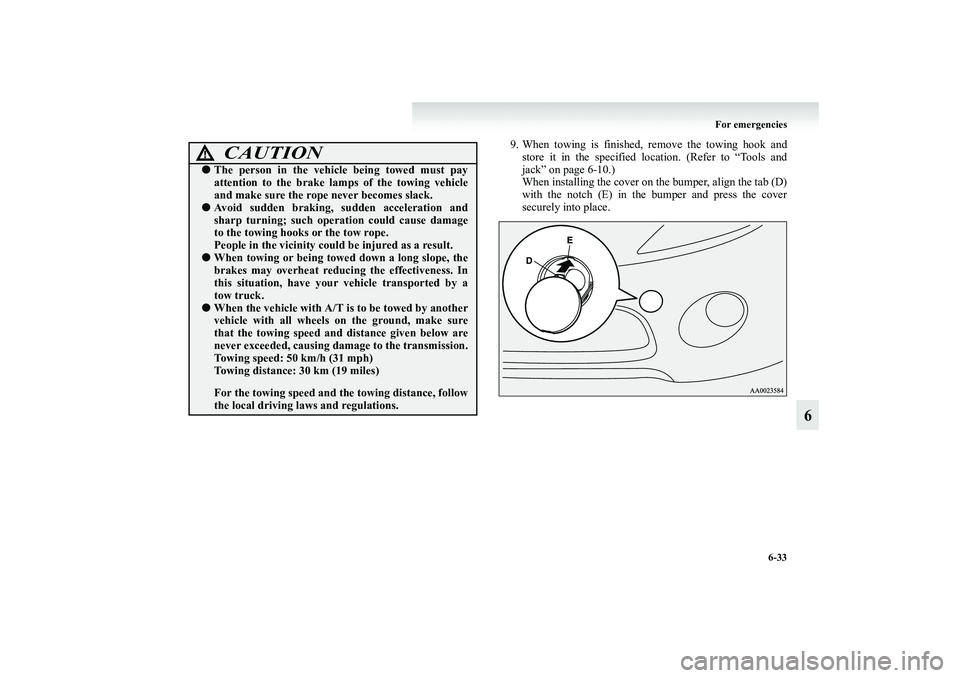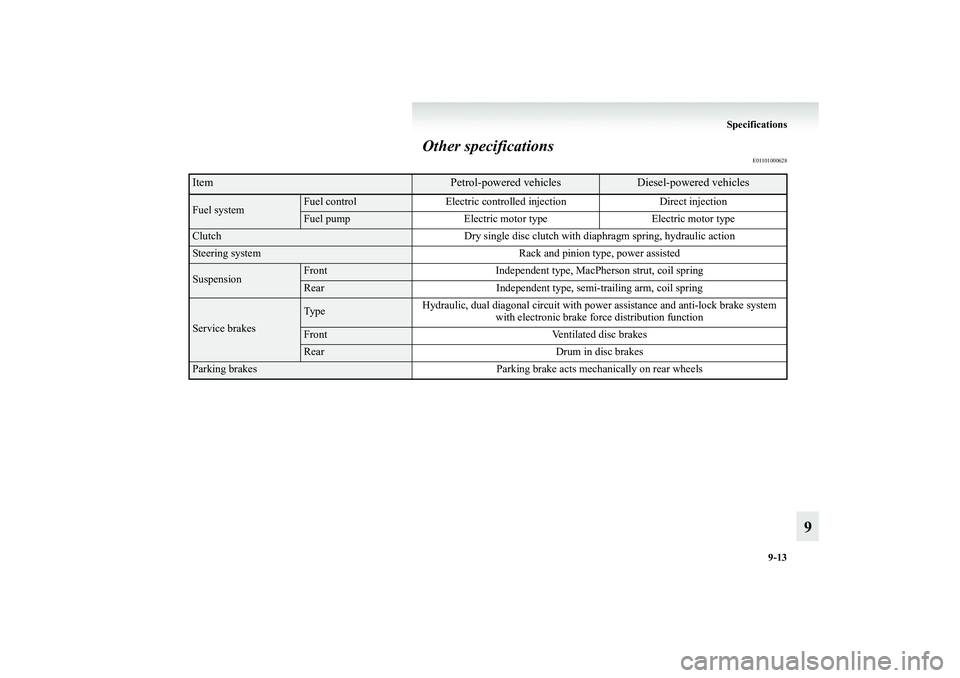2008 MITSUBISHI GRANDIS brakes
[x] Cancel search: brakesPage 234 of 458

4-62 Starting and driving
4
Operating hints●Do not let the clutch slip (vehicles with M/T only) and do
not increase the engine speed more than necessary when
starting.
●Be sure that the driving speed does not exceed the
100 km/h (62 mph) for trailer operation.
It is also recommended that you obey the local regulations
in case driving speed with a trailer is limited to less than
100 km/h (62 mph).
●To prevent shocks from the overrun brake, depress the
brake pedal lightly at first and then more strongly.
●To make full use of engine braking, change to a lower
gear before descending a slope.
●The body, brakes, clutch, and chassis will be under addi-
tional strain when towing a trailer.
●The heavier weight and higher rolling and air resistance
will increase fuel consumption.Additional precautions for vehicles equipped with A/TThe 2nd gear (in sports mode) is recommended on slopes or at
low speed. Use the 1st gear (in sports mode) in mountainous
areas in order to make better use of engine braking and to assist
the brake system. However, be sure that the speed does not
exceed the maximum speed limit for the selected gear.BK-XP08E1ENUK.en-uk.book Page 62 Monday, August 13, 2007 2:20 PM
Page 345 of 458

For emergencies
6-33
6
9. When towing is finished, remove the towing hook and
store it in the specified location. (Refer to “Tools and
jack” on page 6-10.)
When installing the cover on the bumper, align the tab (D)
with the notch (E) in the bumper and press the cover
securely into place.
CAUTION
!●The person in the vehicle being towed must pay
attention to the brake lamps of the towing vehicle
and make sure the rope never becomes slack.●Avoid sudden braking, sudden acceleration and
sharp turning; such operation could cause damage
to the towing hooks or the tow rope.
People in the vicinity could be injured as a result.●When towing or being towed down a long slope, the
brakes may overheat reducing the effectiveness. In
this situation, have your vehicle transported by a
tow truck.●When the vehicle with A/T is to be towed by another
vehicle with all wheels on the ground, make sure
that the towing speed and distance given below are
never exceeded, causing damage to the transmission.
Towing speed: 50 km/h (31 mph)
Towing distance: 30 km (19 miles)
For the towing speed and the towing distance, follow
the local driving laws and regulations.
BK-XP08E1ENUK.en-uk.book Page 33 Monday, August 13, 2007 2:20 PM
Page 347 of 458

For emergencies
6-35
6 Operation under adverse driving conditions
E00801701404
If your vehicle becomes stuck in sand, mud or
snowIf the vehicle becomes stuck in snow, sand, or mud, it can often
be moved by a rocking motion. Move the selector lever alter-
nately between the Sports mode and “R” (REVERSE) position
(with M/T, between 1st and Reverse), while applying slight
pressure to the accelerator pedal.
Avoid racing the engine or spinning the wheels. Prolonged
efforts to free a stuck vehicle may result in overheating and
transmission failure. Allow the engine to idle for a few minutes
to let the transmission cool between rocking attempts.
If the vehicle remains stuck after several rocking attempts, seek
other assistance.
On a flooded road●Avoid flooded roads. Water could enter the brake discs,
resulting in temporarily ineffective brakes. In such cases,
lightly depress the brake pedal to see if the brakes operate
properly. If they do not, lightly depress the pedal several
times while driving in order to dry the brake pads.
●When driving in rain or on a road with many puddles a
layer of water may form between the tyres and the road
surface.
This reduces a tyre’s frictional resistance on the road,
resulting in loss of steering stability and braking capabil-
ity.
To cope with this, observe the following items:
WARNING
!●When attempting to rock your vehicle out of a stuck
position, be sure that the area around the vehicle is
clear of people and physical objects. The rocking
motion may cause the vehicle to suddenly launch
forward or backward, causing injury or damage to
nearby people or objects.
(a) Drive your vehicle at a slow speed.
(b) Do not drive on worn tyres. Always maintain the
specified tyre inflation pressures.
BK-XP08E1ENUK.en-uk.book Page 35 Monday, August 13, 2007 2:20 PM
Page 348 of 458

6-36 For emergencies
6
On a snow-covered or frozen road ●When driving on a snow-covered or frozen road, it is rec-
ommended that you use snow tyres or tyre chains.
Refer to the “Snow tyres” and “Tyre chains” sections.
●Avoid high-speed operation, sudden acceleration, abrupt
brake application and sharp cornering.
●Depressing the brake pedal during travel on snowy or icy
roads may cause tyre slippage and skidding. When trac-
tion between the tyres and the road is reduced the wheels
may skid and the vehicle cannot readily be brought to a
stop by conventional braking techniques. Braking will dif-
fer, depending upon whether you have anti-lock brakes
(ABS). As your vehicle is equipped with anti-lock brakes
(ABS), brake by pressing the brake pedal hard, and keep-
ing it pressed.
●Allow extra distance between your vehicle and the vehicle
in front of you, and avoid sudden braking.
On bumpy or rutted roadDrive as slow as possible when driving on bumpy or rutted
roads.
CAUTION
!●The impact on tyres and/or wheels driving on a
bumpy or rutted road can damage the tyre and /or
wheel.
BK-XP08E1ENUK.en-uk.book Page 36 Monday, August 13, 2007 2:20 PM
Page 353 of 458

Vehicle care
7-5
7
During cold weatherThe salt and other chemicals spread on the roads in some areas
in winter can have a harmful effect on the vehicle body. You
should therefore wash the vehicle as often as possible in
accordance with our care-instructions. It is recommended to
have a preservative applied and the underfloor protection
checked before and after the cold weather season.
After washing your vehicle, wipe off all waterdrops from the
rubber parts around the doors to prevent the doors from freez-
ing.NOTE●To prevent freezing of the weatherstripping on the doors,
bonnet, etc., they should be treated with silicone spray.
●Refrain from using a car wash as its brushes may
scratch the paint surface, causing it to lose its gloss.
Scratches will be especially visible on darker col-
oured vehicles.●Never spray or splash water on the electrical compo-
nents in the engine compartment, as this may
adversely affect engine starting.
Exercise caution also when washing the underbody;
be careful not to spray water into the engine com-
partment.●Some types of hot water washing equipment apply
high pressure and heat to the vehicle. They may
cause heat distortion and damage to the vehicle resin
parts and may result in flooding of the vehicle inte-
rior. Therefore; observe the following.
• Maintain a good distance of approx. 50 cm or more
between the vehicle body and the washing nozzle.
• When washing around the door glass, hold the
nozzle at a distance of more than 50 cm and at
right angles to the glass surface.
●Using an automatic car wash, pay attention to the
following items, refering to the operation manual or
consulting a car wash operator. If the following pro-
cedure is not followed, it could result in damage to
your vehicle.
• The outside mirrors are retracted.
• The rear wiper arm assembly is taped or removed.
• If your vehicle is equipped with a rear deflector or
roof rails, consult a car wash operator before using
the car wash.CAUTION
!
●After washing the vehicle, drive the vehicle slowly
while lightly depressing the brake pedal several
times in order to dry out the brakes.
Leaving the brakes wet could result in reduced
braking performance.
Also, there is a possibility that they could freeze up
or become inoperative due to rust, rendering the
vehicle unable to move.
CAUTION
!
BK-XP08E1ENUK.en-uk.book Page 5 Monday, August 13, 2007 2:20 PM
Page 431 of 458

Specifications
9-13
9 Other specifications
E01101000628
Item
Petrol-powered vehicles
Diesel-powered vehicles
Fuel system
Fuel control Electric controlled injection Direct injectionFuel pump Electric motor type Electric motor type
Clutch Dry single disc clutch with diaphragm spring, hydraulic actionSteering system Rack and pinion type, power assistedSuspension
Front Independent type, MacPherson strut, coil springRear Independent type, semi-trailing arm, coil spring
Service brakes
TypeHydraulic, dual diagonal circuit with power assistance and anti-lock brake system
with electronic brake force distribution functionFront Ventilated disc brakesRear Drum in disc brakes
Parking brakes Parking brake acts mechanically on rear wheels
BK-XP08E1ENUK.en-uk.book Page 13 Monday, August 13, 2007 2:20 PM
Page 441 of 458

Alphabetical index
1
A
Accessory socket 5-57
Accessory (Installation) 5
Active skid control (ASC) system 4-41
Active stability control system (ASC)
Indication lamp 4-43
Additional equipment 8-32
Air bag 2-53
Air conditioning
Front automatic air conditioning 5-7
Important operation tips for the air conditioning 5-19
Rear automatic air conditioning 5-16
Air purifier (with deodorizing function) 5-20
Antenna
Glass antenna 5-52
Anti-lock brake system (ABS) 4-36
Warning lamp 4-38
Armrest 2-7, 2-11
Ashtray 5-54
Audio
Error codes 5-47
Handling of compact discs 5-49
LW/MW/FM electronic tuning radio with CD player 5-21
Automatic headlamp levelling 3-36
Automatic headlamp levelling warning lamp 3-36
Automatic transmission
Fluid 8-13, 9-16
Selector lever operation 4-26Sports mode 4-30
Auto-speed (cruise) control 4-45
Indication lamp 4-46
B
Battery 8-16
Charge warning lamp 3-13
Discharged battery (Emergency starting) 6-2
Specification 9-11
Bonnet 8-4
Bottle holder 5-69
Brake
Anti-lock brake 4-36
Braking 4-35
Fluid 8-14, 9-16
Parking brake 4-6
Parking brake stroke 8-28
Pedal free play 8-28
Power brakes 4-35
Warning lamp 3-10
Bulb capacity 8-44
C
Capacities 9-16
Card holder 5-53, 5-72
Cargo loads 4-57
Cargo net 5-78
Catalytic converter 8-3
Central door locks 1-9
BK-XP08E1ENUK.en-uk.book Page 1 Monday, August 13, 2007 2:20 PM
Page 445 of 458

Alphabetical index
5
O
Odometer 3-4
Oil
Engine oil 8-7
Manual transmission oil 9-16
Oil pressure warning lamp 3-14
Operation under adverse driving conditions 6-35
Other specifications 9-13
Outside rear-view mirrors 4-10
Overheating 6-7
P
Parking 4-7
Parking brake 4-6
Parking brake stroke 8-28
Personal box 5-66
Personal table 5-72
Position lamps
Bulb capacity 8-44
Indication lamp 3-9
Replacement 8-51
Power brakes 4-35
Power steering
Fluid 8-15, 9-16
System 4-40
Precautions to observe when using wipers and washers 3-44
Pregnant women restraint 2-38
Puncture (Tyre changing) 6-20
R
Radio
LW/MW/FM electronic tuning radio with CD player 5-21
Rear automatic air conditioning 5-16
Rear combination lamps
Bulb capacity 8-44
Replacement 8-54
Rear cooler 5-15
Rear fog lamp
Bulb capacity 8-44
Indication lamp 3-9
Replacement 8-54
Switch 3-40
Rear heater 5-15
Rear personal lamps 5-61
Bulb capacity 8-45
Replacement 8-58
Rear side box 5-67
Rear turn-signal lamps
Bulb capacity 8-44
Replacement 8-54
Rear window demister switch 3-45
Rear-view mirror
Inside 4-9
Outside 4-10
Replacement of lamp bulbs 8-43
Reversing lamps
Bulb capacity 8-44
BK-XP08E1ENUK.en-uk.book Page 5 Monday, August 13, 2007 2:20 PM